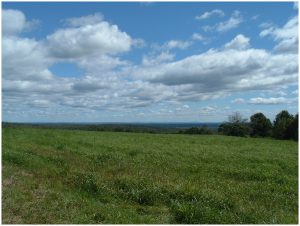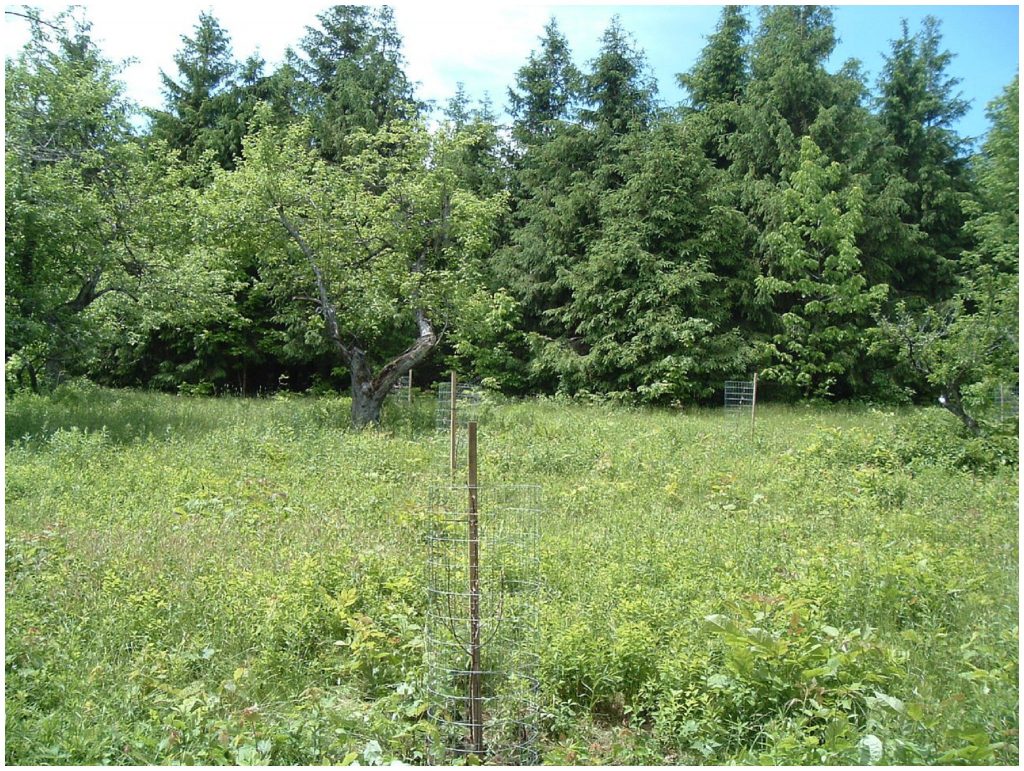May 25, 2016 at 12:47 pm
[caption id="attachment_1513" align="alignleft" width="300"] View from Bud Leavitt WMA towards the western mountains[/caption]
By Mark Caron, Regional Wildlife Biologist
The Bud Leavitt Wildlife Management Area comprises 6,530 acres across portions of four towns including Dover-Foxcroft, Atkinson, Garland, and Charleston (Delorme Atlas, Map 32). The WMA is composed largely of upland habitat types and including 80 acres of maintained fields. Much of the upland forest was once active agricultural land as evidenced by old stone walls and apple trees scattered across the WMA. Wetland habitats are limited to active and abandoned beaver flowages located along small streams. A 1,000 (+) acre raised level bog ecosystem associated with Black Stream is located in portions of all four towns.
[caption id="attachment_1509" align="alignright" width="300"]
View from Bud Leavitt WMA towards the western mountains[/caption]
By Mark Caron, Regional Wildlife Biologist
The Bud Leavitt Wildlife Management Area comprises 6,530 acres across portions of four towns including Dover-Foxcroft, Atkinson, Garland, and Charleston (Delorme Atlas, Map 32). The WMA is composed largely of upland habitat types and including 80 acres of maintained fields. Much of the upland forest was once active agricultural land as evidenced by old stone walls and apple trees scattered across the WMA. Wetland habitats are limited to active and abandoned beaver flowages located along small streams. A 1,000 (+) acre raised level bog ecosystem associated with Black Stream is located in portions of all four towns.
[caption id="attachment_1509" align="alignright" width="300"] 2-acre food plot at Bud Leavitt WMA[/caption]
Visitors can enjoy a wide variety of recreational opportunities including small and big game hunting, trapping, horseback riding, snowmobiling, and bird watching particularly during the spring and fall migrations. There are excellent views from HI CUT (located in the Garland portion of the WMA) towards the western mountains and north to Mount Katahdin. Both the Charleston and Garland ATV clubs maintain a marked trail thru portions of the WMA, and the Dover-Foxcroft Snowmobile Club also maintains a designated trail. There are also several unimproved roads located throughout the WMA.
[caption id="attachment_1511" align="alignleft" width="300"]
2-acre food plot at Bud Leavitt WMA[/caption]
Visitors can enjoy a wide variety of recreational opportunities including small and big game hunting, trapping, horseback riding, snowmobiling, and bird watching particularly during the spring and fall migrations. There are excellent views from HI CUT (located in the Garland portion of the WMA) towards the western mountains and north to Mount Katahdin. Both the Charleston and Garland ATV clubs maintain a marked trail thru portions of the WMA, and the Dover-Foxcroft Snowmobile Club also maintains a designated trail. There are also several unimproved roads located throughout the WMA.
[caption id="attachment_1511" align="alignleft" width="300"] Highbush cranberries[/caption]
Forest and wildlife habitat management occur across the WMA. Sustainable timber production is conducted in balance with wildlife habitat management objectives. Mast producing trees including red oak, beech, chestnut and apple trees are maintained and enhanced to benefit wildlife. Several habitat management practices occur at Bud Leavitt annually or as scheduled. These include grouse and woodcock management, annual mowing of fields, maintaining a recently planted 2-acre food plot, annual maintenance of both bluebird and duck boxes, and the planting of a variety of hard and soft mast trees and shrubs throughout the WMA.
Directions: The Bud Leavitt WMA can be accessed by several roads including Route 15, the Garland/Center Road, Whiting Road, and the Atkinson Road. Click here for a map
[caption id="attachment_1510" align="aligncenter" width="686"]
Highbush cranberries[/caption]
Forest and wildlife habitat management occur across the WMA. Sustainable timber production is conducted in balance with wildlife habitat management objectives. Mast producing trees including red oak, beech, chestnut and apple trees are maintained and enhanced to benefit wildlife. Several habitat management practices occur at Bud Leavitt annually or as scheduled. These include grouse and woodcock management, annual mowing of fields, maintaining a recently planted 2-acre food plot, annual maintenance of both bluebird and duck boxes, and the planting of a variety of hard and soft mast trees and shrubs throughout the WMA.
Directions: The Bud Leavitt WMA can be accessed by several roads including Route 15, the Garland/Center Road, Whiting Road, and the Atkinson Road. Click here for a map
[caption id="attachment_1510" align="aligncenter" width="686"] Crabapple trees planted alongside apple trees at Bud Leavitt WMA[/caption]
Crabapple trees planted alongside apple trees at Bud Leavitt WMA[/caption]
 View from Bud Leavitt WMA towards the western mountains[/caption]
By Mark Caron, Regional Wildlife Biologist
The Bud Leavitt Wildlife Management Area comprises 6,530 acres across portions of four towns including Dover-Foxcroft, Atkinson, Garland, and Charleston (Delorme Atlas, Map 32). The WMA is composed largely of upland habitat types and including 80 acres of maintained fields. Much of the upland forest was once active agricultural land as evidenced by old stone walls and apple trees scattered across the WMA. Wetland habitats are limited to active and abandoned beaver flowages located along small streams. A 1,000 (+) acre raised level bog ecosystem associated with Black Stream is located in portions of all four towns.
[caption id="attachment_1509" align="alignright" width="300"]
View from Bud Leavitt WMA towards the western mountains[/caption]
By Mark Caron, Regional Wildlife Biologist
The Bud Leavitt Wildlife Management Area comprises 6,530 acres across portions of four towns including Dover-Foxcroft, Atkinson, Garland, and Charleston (Delorme Atlas, Map 32). The WMA is composed largely of upland habitat types and including 80 acres of maintained fields. Much of the upland forest was once active agricultural land as evidenced by old stone walls and apple trees scattered across the WMA. Wetland habitats are limited to active and abandoned beaver flowages located along small streams. A 1,000 (+) acre raised level bog ecosystem associated with Black Stream is located in portions of all four towns.
[caption id="attachment_1509" align="alignright" width="300"] 2-acre food plot at Bud Leavitt WMA[/caption]
Visitors can enjoy a wide variety of recreational opportunities including small and big game hunting, trapping, horseback riding, snowmobiling, and bird watching particularly during the spring and fall migrations. There are excellent views from HI CUT (located in the Garland portion of the WMA) towards the western mountains and north to Mount Katahdin. Both the Charleston and Garland ATV clubs maintain a marked trail thru portions of the WMA, and the Dover-Foxcroft Snowmobile Club also maintains a designated trail. There are also several unimproved roads located throughout the WMA.
[caption id="attachment_1511" align="alignleft" width="300"]
2-acre food plot at Bud Leavitt WMA[/caption]
Visitors can enjoy a wide variety of recreational opportunities including small and big game hunting, trapping, horseback riding, snowmobiling, and bird watching particularly during the spring and fall migrations. There are excellent views from HI CUT (located in the Garland portion of the WMA) towards the western mountains and north to Mount Katahdin. Both the Charleston and Garland ATV clubs maintain a marked trail thru portions of the WMA, and the Dover-Foxcroft Snowmobile Club also maintains a designated trail. There are also several unimproved roads located throughout the WMA.
[caption id="attachment_1511" align="alignleft" width="300"] Highbush cranberries[/caption]
Forest and wildlife habitat management occur across the WMA. Sustainable timber production is conducted in balance with wildlife habitat management objectives. Mast producing trees including red oak, beech, chestnut and apple trees are maintained and enhanced to benefit wildlife. Several habitat management practices occur at Bud Leavitt annually or as scheduled. These include grouse and woodcock management, annual mowing of fields, maintaining a recently planted 2-acre food plot, annual maintenance of both bluebird and duck boxes, and the planting of a variety of hard and soft mast trees and shrubs throughout the WMA.
Directions: The Bud Leavitt WMA can be accessed by several roads including Route 15, the Garland/Center Road, Whiting Road, and the Atkinson Road. Click here for a map
[caption id="attachment_1510" align="aligncenter" width="686"]
Highbush cranberries[/caption]
Forest and wildlife habitat management occur across the WMA. Sustainable timber production is conducted in balance with wildlife habitat management objectives. Mast producing trees including red oak, beech, chestnut and apple trees are maintained and enhanced to benefit wildlife. Several habitat management practices occur at Bud Leavitt annually or as scheduled. These include grouse and woodcock management, annual mowing of fields, maintaining a recently planted 2-acre food plot, annual maintenance of both bluebird and duck boxes, and the planting of a variety of hard and soft mast trees and shrubs throughout the WMA.
Directions: The Bud Leavitt WMA can be accessed by several roads including Route 15, the Garland/Center Road, Whiting Road, and the Atkinson Road. Click here for a map
[caption id="attachment_1510" align="aligncenter" width="686"] Crabapple trees planted alongside apple trees at Bud Leavitt WMA[/caption]
Crabapple trees planted alongside apple trees at Bud Leavitt WMA[/caption]Categories